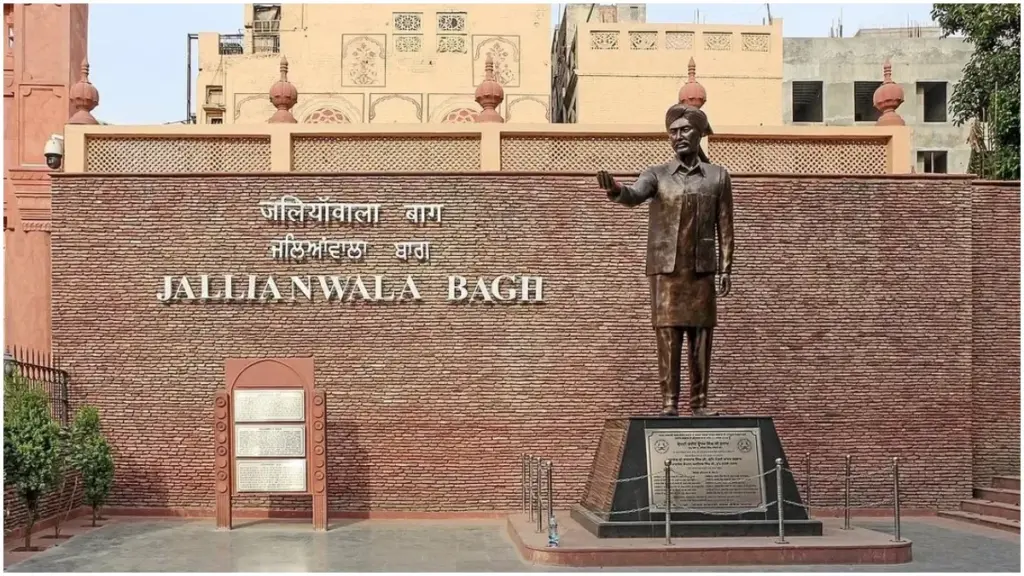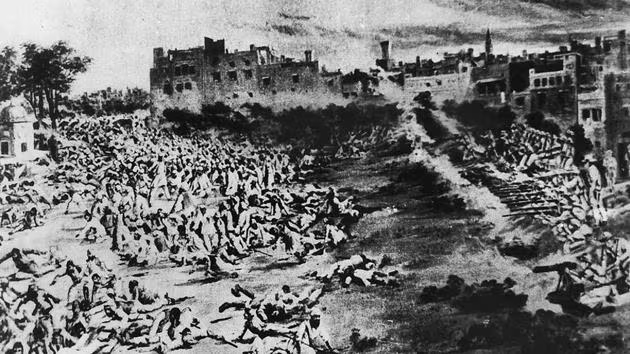You know how some places just hit different?
They’re not always the grandest or the most picturesque, but the moment you step in, something changes. The air feels heavier. Your footsteps slow down. And suddenly, you’re not just a visitor, you’re a witness.
That’s exactly how I felt the day I walked into Jallianwala Bagh, right in the heart of Amritsar. I had heard the stories, studied the facts, even watched documentaries. But none of it prepared me for what I felt when I was actually there.
A Garden with Ghosts
At first glance, Jallianwala Bagh doesn’t scream for attention. It’s tucked away behind a small gateway, just a few steps from the ever-bustling lanes that lead to the Golden Temple. The entrance is narrow, barely wide enough for two people to walk side by side. You walk in single file, and it almost feels like you’re being funneled into something.
And maybe that’s the point. That very passage was once the only exit available to thousands of people trapped inside. On April 13, 1919, it became a death trap.
As you pass through the entrance, the garden opens up. You see pathways, well-trimmed hedges, a towering memorial, and families taking photos. But something hangs in the air, something unspoken. It’s not eerie, exactly. But it’s not just peaceful either. It’s a space where the past has rooted itself so deeply that you can almost hear its whispers.
What Really Happened on April 13, 1919?
Let’s rewind a bit. April 13, 1919, Baisakhi day. For those unfamiliar, Baisakhi is one of Punjab’s most vibrant festivals. It marks the harvest season, and it’s usually celebrated with dancing, food, music, and a general sense of joy.
But that year, the air in Amritsar was tense.
The British government had recently passed the Rowlatt Act, a law that allowed the colonial regime to imprison Indians without trial. Protests had been spreading across the country, and in Amritsar, many gathered at Jallianwala Bagh to voice their dissent in a peaceful assembly. Others were simply there to enjoy the holiday.
Then came Brigadier General Reginald Dyer.
Without any warning, Dyer arrived with about 90 armed soldiers. He positioned them at the only exit and, without a word of caution or an attempt at negotiation, ordered them to open fire.
They kept shooting for ten straight minutes. Over 1,600 bullets were fired into a crowd that had nowhere to run. Estimates vary, but Indian records claim over 1,000 people died, many of them women and children. The official British count was significantly lower, but the truth lies somewhere in those silent screams.
Can you picture it?
Imagine being in a crowded park, surrounded by walls with no way out—and then the gunfire starts. Where do you go? What do you do?

My Experience Standing in the Middle of It All
When I reached the far end of the garden, I saw the bullet-ridden wall. And I mean that literally. You can still see the bullet marks, each one preserved with a small black square around it. One mark was barely two feet off the ground. I remember staring at it and thinking: someone was probably trying to protect their child there, crouched low, shielding them with their body.
It’s one thing to read about history, to memorise dates and names and facts. But it’s another thing entirely to stand where it happened. To look at that wall and know, this isn’t a movie set. This isn’t a dramatisation. Real people bled here. Real people died.
I saw a group of schoolchildren walk in with their teacher. You’d expect noise, maybe some giggling or pushing. But they were quiet. Strangely quiet. They walked past the wall, whispering questions.
“Why didn’t anyone stop it?”
“Did they know they were going to die?”
“Was there no one to help them?”
And I stood there thinking—those questions still don’t have answers. Not satisfying ones, anyway.

The Martyrs’ Well: A Symbol of Desperation
In one corner of the garden is a well—Martyrs’ Well, as it’s now known. During the massacre, over 120 people jumped into it, hoping to escape the hail of bullets. They died anyway. Some drowned. Others were shot mid-air.
Standing beside that well, peering down into its dark mouth, I couldn’t help but feel a lump rise in my throat. Can you imagine what kind of desperation it takes to jump into a well, knowing death is likely either way? That kind of fear… it’s unthinkable.
And yet, it happened. Here. Less than a hundred years ago. In a place you can visit today for free.
History Isn’t Just a School Subject
Let’s be honest. Most of us encountered Jallianwala Bagh for the first time in school textbooks. Maybe a paragraph. Maybe a question on an exam: “Who ordered the Jallianwala Bagh massacre?”
But textbooks don’t carry emotion. They don’t convey the sound of panicked screams, or the thud of bodies hitting the ground. They don’t tell you how families waited for loved ones who never came home. Or how the ground stayed stained with blood for days.
Visiting the site changes that. It makes it real. It makes it human.

Why We Must Keep Remembering
In today’s world of fast-paced news and constant digital distraction, it’s easy to forget the past. We scroll past tragedy. We move on quickly. But Jallianwala Bagh is a reminder that forgetting can be dangerous.
Because if we forget what oppression looks like, how do we recognize it when it returns?
If we forget how power can be abused, how do we protect the vulnerable?
Jallianwala Bagh isn’t just a place. It’s a story. A warning. A wound. And wounds, as much as we want to cover them, must sometimes be left open just long enough to remind us why we must never let them happen again.
A Space for Reflection, Not Just Remembrance
There’s a memorial flame in the center of the garden now. It stands tall, surrounded by inscriptions and the names of those who died. But what struck me more than the monument itself was how people behaved around it.
They weren’t rushing to take selfies. They weren’t chatting loudly. Most stood quietly. Some read the plaques. Others just stared, lost in thought.
I remember sitting on a bench nearby, watching an old man with a walking stick lean down and touch the ground. Maybe he lost someone here. Maybe he was just paying respects. But that moment. small, personal, unspoken, said more than any history book ever could.
If You’re Visiting Amritsar, Don’t Skip This
I know a lot of people visit Amritsar for the Golden Temple and rightfully so. It’s stunning, spiritual, and full of warmth. But if you’re there, make time for Jallianwala Bagh. Not just as a tourist. Not just to check a box. But to feel it. To absorb it.
Here’s what you should do when you go:
- Walk through the museum. It’s small but powerful. Letters, photos, newspaper clippings—all firsthand accounts of the massacre.
- Stand at the wall. Don’t just glance at the bullet holes. Really look. Try to imagine the chaos of that moment.
- Read the names. Each name is a life cut short. A story unfinished.
- Visit the well. Not just to see it—but to understand what it meant for those who jumped in.
- Take a moment to sit. Let the silence speak to you.
Quick Facts for Context
Just in case you’re looking for the key information:
- Location: Jallianwala Bagh is located near the Golden Temple in Amritsar, Punjab.
- Date of the Massacre: April 13, 1919 (Baisakhi Day).
- The Offender: General Reginald Dyer of the British Army.
- Estimated Bullets Fired: Around 1,650 rounds in 10 minutes.
- Casualties: British records state 379 dead, but Indian estimates go well above 1,000.
- Post-Massacre Reaction: Widespread outrage across India; Rabindranath Tagore renounced his knighthood in protest.

Some Wounds Shape Us
I left Jallianwala Bagh that day with a strange feeling. Not sadness exactly. Not anger either. But something deeper. A kind of quiet responsibility.
Because once you’ve stood where history bled, you can’t unfeel it.
Jallianwala Bagh is not just about loss. It’s about resilience. About people who rose, even after being brought to their knees. About how one act of brutality sparked a national movement, pushing India further toward independence.
Also Read: The Many Names of Lord Jagannath: A Divine Journey Through Time and Faith
And maybe that’s the lesson. That even in our darkest hours, we hold the power to rise. To remember. To resist.
So if you ever find yourself in Amritsar, make that narrow walk through the gate. Stand in the garden. Listen to the silence. And let history speak.
Some stories aren’t meant to be told from a distance. They’re meant to be felt—up close, personal, and unforgettable.
FAQs
1. Why is Jallianwala Bagh famous?
Jallianwala Bagh is known for the tragic massacre that occurred on April 13, 1919, when British troops fired on a peaceful gathering, killing hundreds of unarmed civilians. It became a turning point in India’s freedom struggle.
2. What can you see at Jallianwala Bagh today?
Visitors can see preserved bullet marks on the walls, the Martyrs’ Well, memorial plaques, a flame monument, and a museum showcasing photos, documents, and eyewitness accounts.
3. Is there an entry fee for Jallianwala Bagh?
No, entry to Jallianwala Bagh is free. It is open to the public and located within walking distance of the Golden Temple in Amritsar.
4. How did the Jallianwala Bagh massacre impact India’s freedom movement?
The massacre fueled nationwide outrage, led to widespread protests, and united Indians against colonial rule. Leaders like Mahatma Gandhi intensified their efforts for independence following the tragedy.


